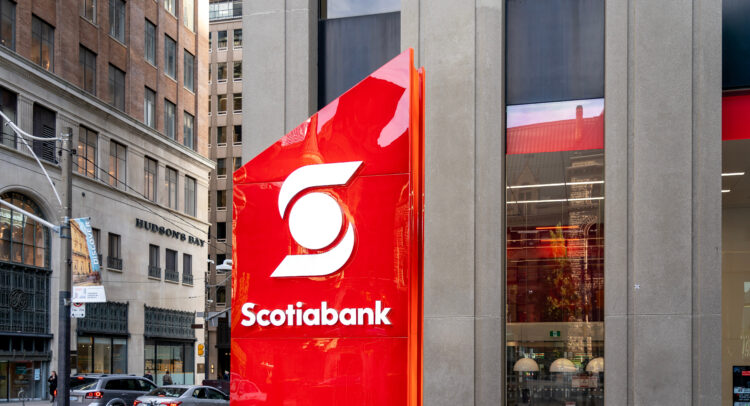Bank of Nova Scotia (NYSE:BNS)(TSE:BNS) is one of the big six Canadian banks and has significant international exposure. Despite poor macro conditions in Canada, I’m neutral on Bank of Nova Scotia because of its exposure to Latin America and potential to improve its profitability in the long run. With high balance sheet leverage and stretched debt-service ratios (DSR) in Canada, I think there are risks and opportunities for BNS.
Claim 50% Off TipRanks Premium and Invest with Confidence
- Unlock hedge-fund level data and powerful investing tools designed to help you make smarter, sharper decisions
- Stay ahead of the market with the latest news and analysis so your portfolio is always positioned for maximum potential

Canadian Bank Earnings May be Overstated
I have been bearish on Canadian banks for some time now. While much of the world has been deleveraging since 2008, Canadians haven’t been part of that majority. As Canada’s historically high debt levels collide with high interest rates, I believe the country could face a significant 2008-style deleveraging. This means Canadian banks may face substantial increases in their provisions for credit losses.
For example, Bank of Nova Scotia had 0.86% of its loan book reserved as an “allowance for loan losses.” Yes, less than 1%. Citigroup (NYSE:C), a U.S. bank with similar international exposure, has 2.71% of its loan book reserved. This begs the question: are Canadians really three times less likely to default than Americans? Probably not.
Debt-service payments made up 15% of Canadians’ disposable income in Q4 of 2023, and this is just the average. In the U.S., this ratio reached an all-time high of 13.3% in Q4 of 2007, right before the Great Financial Crisis. This is not a coincidence. When consumers are allocating a huge portion of their income to service debts, they’re more likely to default.
So, how does this 15% Canadian DSR compare to the U.S. today? Today, Americans have a debt-service ratio of just 9.8%. This is why I believe Canadian banks are substantially underreporting their provisions for credit losses, which eat into net income. Luckily for Bank of Nova Scotia, the Canadian business is only about half its earnings. See below.

A Recession Could Cause Stricter Capital Requirements
After the Great Financial Crisis, regulators began forcing large U.S. banks (unfortunately, not small ones like SVB and First Republic) to hold more equity capital compared to their assets. This equity buffer helps shield banks from losses. For example, Citigroup had an assets-to-equity ratio of 16-to-1 in 2006 and 19-to-1 in 2007. Today, its balance sheet is much more conservative, with this ratio standing at just under 12-to-1.
In comparison, the big Canadian banks tend to have assets-to-equity ratios of around 17-to-1, which is the case for Bank of Nova Scotia. This is still in the danger zone, in my opinion, because the Canadian economy is very leveraged as well. Like U.S. banks in 2007, Canadian banks have been levered up for some time now, and this wasn’t a problem because interest rates declined for decades. In recent years, that has changed.
If Canada experiences a bad recession and some banks get into trouble, Canadian regulators could crack down on capital requirements. If Bank of Nova Scotia and other banks are forced to build more equity quickly, the options to do that aren’t very favorable for shareholders. Here are some of the options: sell assets, issue stock (dilute shareholders), cut the dividend, and/or postpone share buybacks.
Now, will this actually happen? I don’t know for sure. European banks kept their high leverage, even after the 2008 failures and bailouts of banks like the Royal Bank of Scotland. This may be partially why Credit Suisse collapsed in 2023.
There Are Opportunities as Well
I recently read the CEO’s message in Bank of Nova Scotia’s 2023 annual report. The bank is beginning to cut costs, which is resulting in near-term restructuring charges. However, with the bank currently only earning a 0.56% return on assets, I believe there is room for earnings improvement in the long term. We just have to hope there isn’t an equity issuance or bailout in Canada in the near term.
Also, Bank of Nova Scotia’s assets in South America and Central America have dramatically underperformed, causing Bank of Nova Scotia to underperform other Canadian banks. Currency depreciation hasn’t helped. I see this trend reversing. I believe many Latin American economies are better positioned than Canada and the United States. Mexico, for example, has extremely low household debt levels and similarly low government debt levels. There’s a lot of room for growth there.
Is BNS Stock a Buy, According to Analysts?
Currently, zero out of seven analysts covering BNS give it a Buy rating, six rate it a Hold, and one analyst rates it a Sell, resulting in a Hold consensus rating. The average BNS stock price target is $49.31, implying upside potential of 6.3%.

The Bottom Line on BNS Stock
I am “decisively” neutral on BNS stock. I like the company’s international exposure, which could switch from a headwind to a tailwind with strong economics in Latin American countries like Mexico. Also, the company’s cost-cutting measures could yield better returns on assets in the long term.
That said, I think Canadian banks are understating the loan losses that are coming. A stretched debt-service ratio for the Canadian consumer signals trouble. So, expect much higher provisions for credit losses to eat into earnings. Also, BNS, like other Canadian banks, has an assets-to-equity ratio of about 17-to-1, similar to where Citigroup was before it crashed in 2008. I think regulators could force BNS and other Canadian banks to hold more capital following a potential hard landing in Canada.
















